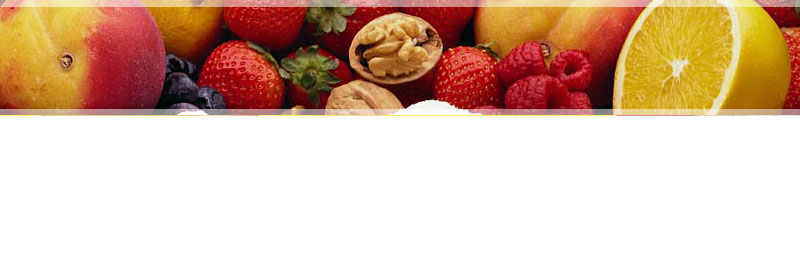| Fruit Food Group | ||||||||
| print the page | email the page |  |
|
|||||
- Foods included in the fruit food group
- How much of the fruit food group is needed
- Why the fruit food group is good for you
- Portion size
- More information
Foods included in the fruit food group
All fruit foods are included in the fruit food group. There are a variety of different types of fruits, including:
- berries - blueberry, raspberry, strawberry
- citrus - grapefruit, lime, lemon, orange, tangerines
- melons - honeydew, rockmelon (cantaloupe), watermelon
- stone - apricot, cherry, nectarine, peach, plum
- tropical - banana, mango, papaya, pineapple
- others - apple, avocado, dates, figs, grapes, pear
How much of the fruit food group is needed
The amount of fruits required each day is dependent on the age and gender of the individual. Fruits contain high levels of vitamin C, betacarotene, potassium, phytochemicals and fibre. The recommended daily intake for this food group is dependent on the age and lifestage of the individual.
** these portions are for inactive to moderately active people; for those that are more active, there is scope to have slightly higher portion sizes
| AGE | PORTION |
|
|---|---|---|
| CHILDREN | 2-3 years 4-8 years |
1 cup 1-1.5 cups |
| GIRLS | 9-13 years 14-18 years |
1.5 cups 1.5 cups |
| BOYS | 9-13 years 14-18 years |
1.5 cups 2 cups |
| WOMEN | 19-30 years 31-50 years 50+ years |
2 cups 1.5 cups 1.5 cups |
| MEN | 19-30 years 31-50 years 50+ years |
2 cups 2 cups 2 cups |
| PREGNANT & LACTATING WOMEN | 19-30 years 31-50 years 50+ years |
2 cups 1.5 cups 1.5 cups |
Advertisement
Why the fruit food group is good for you
The fruit food group is healthy because of the following important reasons:
- may reduce the incidence of stroke and other heart disease
- may protect against certain cancers of digestive system
- foods high in dietary fibre help reduce HDL ("bad") cholesterol levels
- contain high amounts of potassium which assists in reducing high blood pressure and water retention
- provide natural sugars for energy sustenance
- should be eaten raw to gain best health benefits
- has many vital nutrients essential for good health:
- betacarotene
- dietary fibre
- folic acid
- potassium
- vitamin C
Portion sizes for 1 cup (and equivalent) of fruits are shown below:
| 1 portion (1 cup) | |
|---|---|
| apple | 1 cup chopped or sliced 1 small apple (6.5cm diameter) 1/2 large apple (8.5cm diameter) |
| banana | 1 cup sliced or diced 1 large (20cm long) |
| grapes | 32 medium 1 cup whole or sliced |
| orange, mandarin | 1 large (8cm diameter) 1 cup (sections) |
| peach, nectarine | 1 large (7cm diameter) 1 cup sliced or diced |
| pear | 1 medium 1 cup sliced or diced |
| plum | 3 medium or 2 large 1 cup sliced or diced |
| rockmelon (cantaloupe), watermelon |
1 cup diced or balls 1 wedge (2.5cm thick) |
| strawberries (and other berries) |
8 large berries 1 cup sliced or diced |
Advertisement
High Water Content
- most fruits have a high water content and hydrate the body effectively
- fleshy fruits (pineapple, watermelon, peaches, mango) have the highest water content
Essential Nutrients
- an excellent source of Vitamin A / betacarotene, which are effective antioxidants:
- orange fruit - apricots, nectarines, mandarines, oranges, peaches
- red fruit - watermelon
Good source of energy
- fruit contains natural sugars, are low in fat and provide a healthy energy source
- are as a great snack in between meals
Amount of Dietary Fat Recommended
- Dietary fat should consist of no more than 30% of total daily calorie intake - which is about 50g-60g of fat for a sedentary person on 7500kJ (1800 calories) a day
Amount of Dietary Protein Recommended
- Dietary protein should consist of no more than 0.75g per kilogram body weight of total daily calorie intake - women who are pregnant should add another 6g of protein and lactating women should add 16-12g of protein per day
Amount of Dietary Carbohydrate Recommended
- Dietary carbohydrate should consist of 45%-65% of total daily calorie intake - it is recommended that these come from unrefined sources with a lower glycemic index
references
- MyPyramid.gov web site - this is the official food group pyramid devised by the USA Department of Agriculture
- Nutrition Australia - has produced food pyramids for both meat eaters and vegetarians
- Better Health - a guide to the food groups by the Victorian Government


